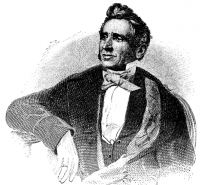










Charles Goodyear was an American self-taught chemist and manufacturing engineer who invented and developed a process to vulcanize rubber in 1839, which he improved while living and working in Springfield, Massachusetts in 1844, and for which he received patent number 3633 from the United States Patent Office on June 15, 1844.
Though Goodyear is often credited with its invention, modern evidence has proven that the Mesoamericans used stabilized rubber for balls and other objects as early as 1600 BC.Goodyear discovered the vulcanization process accidentally after five years of searching for a more stable rubber and stumbling upon the effectiveness of heating.
Early life
Charles Goodyear was born in New Haven, Connecticut, the son of Amasa Goodyear, and the oldest of six children. His father was a descendant of Stephen Goodyear of London, Middlesex, England, one of the founders of the colony of New Haven in 1638.
In 1814, Charles left his home and went to Philadelphia to learn the hardware business. He worked industriously until he was twenty-one years old, and then, returning to Connecticut, entered into partnership in his father’s business in Naugatuck, CT where they manufactured not only ivory and metal buttons, but also a variety of agricultural implements.
Vulcanization
In 1838, Goodyear met Nathaniel Hayward in Woburn, Massachusetts, where Hayward ran a rubber factory. Goodyear was interested in Hayward's process of drying rubber using sulfur, and some time after this Goodyear himself moved to Woburn, where he continued his experiments.
The circumstances of the discovery of vulcanization are described by Goodyear in his book, "Gum Elastic and Its Varieties, with a detailed account of its application and uses and of the Discovery of Vulcanization."
Some say (Damian Francis Mullin, circa Feb 1865) that Goodyear tried the experiment over an open flame, and saw that the gum elastic was charred, but on the edge of the charred areas were portions that were cured instead of charred. Other sources claim that Goodyear accidentally spilled the rubber mixture on a hot stove and observed the effects of vulcanization. Others claim that Hayward was the original discoverer of vulcanization, but Goodyear named it and more successfully marketed and industrialized it.In any case, the key discovery was that heating natural rubber and sulfur created vulcanized rubber, which was refined to become the vulcanizing process. Goodyear himself admitted that the discovery of the vulcanizing process was not discovered via the scientific method, but claims that it was the result of application and observing Mr. Hayward's process rather than pure accident.
Because Goodyear was sure that he had finally created vulcanized rubber, he immediately began to inform his friends and attempted to secure capital. However, his previous failures prevented him from convincing his friends or getting the necessary money. For a number of years, Goodyear and his family suffered in poverty; however, Goodyear continued his work. Eventually he went to New York City and showed vulcanized rubber to William and Emory Ryder, brothers, who immediately realized the value of the discovery and started manufacture. Even here, Goodyear's bad luck seemed to follow him, for the Ryder Bros. had failed and it was impossible to continue the business.
Death
Goodyear died on July 1, 1860, while traveling to see his dying daughter. After arriving in New York, he was informed that she had already died. He collapsed and was taken to the Fifth Avenue Hotel in New York City, where he died at the age of 59. He is buried in New Haven at Grove Street Cemetery.
In 1898, almost four decades after his death, The Goodyear Tire & Rubber Company was founded and named after Goodyear by Frank Seiberling.
On February 8, 1976, he was among six individuals selected for induction into the National Inventors Hall of Fame.
In Woburn, Massachusetts, there is an elementary school named after him.The Government of France made him a Chevalier de la Légion d'honneur in 1855.
The ACS Rubber Division awards a medal named in Goodyear's honor, the Charles Goodyear Medal. The medal honors principal inventors, innovators, and developers whose contributions resulted in a significant change to the nature of the rubber industry.
The Goodyear welt, a technique in handmade shoemaking that significantly increases the lifespan of a shoe used by Wildsmith, one of the oldest English shoemakers and other traditional manufacturers was named after and in honor of its inventor, Charles' son; Charles Goodyear Jr.